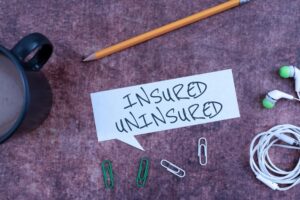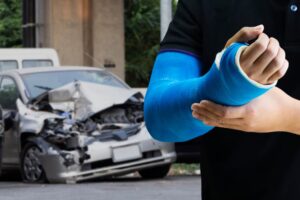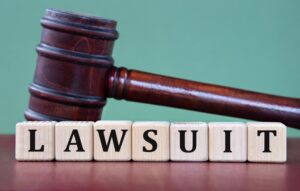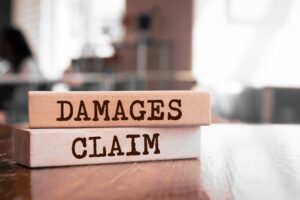Negligent motorists cause car collisions in a variety of ways, from speeding to exhibiting road rage to engaging in distracted driving. However, serious problems can arise when at-fault drivers are totally uninsured or underinsured. An uninsured driver is one who does not have any insurance coverage at all, while an underinsured driver has some insurance coverage, but it is insufficient to cover your total damages.
In these situations, you may need to turn to your own insurance company for compensation by way of an uninsured motorist (UM) claim or an underinsured motorist (UIM) claim. In a UM claim, your insurance company “steps into the shoes” of the at-fault driver and supplies the necessary coverage. However, in a UIM claim, you must first exhaust the at-fault driver’s policy limits of coverage. Then, you can turn to your own insurance company (via a UIM claim) for additional compensation.
A skilled car accident attorney in your jurisdiction can file a UM/UIM claim on your behalf and pursue the compensation you need for your accident-related losses.
How Do Uninsured and Underinsured Motorists Typically Cause Car Accidents?
 Uninsured and underinsured motorists often cause car collisions due to various forms of negligence. Negligence occurs when a driver fails to act responsibly or follow traffic laws, putting others at risk. Below are some of the most common ways that uninsured and underinsured drivers cause crashes:
Uninsured and underinsured motorists often cause car collisions due to various forms of negligence. Negligence occurs when a driver fails to act responsibly or follow traffic laws, putting others at risk. Below are some of the most common ways that uninsured and underinsured drivers cause crashes:
- Speeding – Many collisions occur because drivers go too fast for the road conditions. Uninsured or underinsured drivers may speed because they feel pressure to get somewhere quickly, or they may simply ignore the dangers of driving too fast. Speeding makes it difficult to stop in time, avoid hazards, or react to other vehicles, increasing the likelihood of a crash.
- Distracted Driving – Distracted driving is one of the leading causes of collisions. Distracted driving happens when drivers take their attention away from the road, usually because they are texting, talking on the phone, eating, or using their GPS. Uninsured or underinsured motorists are just as likely as others to engage in these risky behaviors, which can lead to collisions.
- Driving Under the Influence – Operating a vehicle while under the influence of alcohol or drugs is a common cause of serious collisions. Uninsured and underinsured drivers may be more likely to drive under the influence if they cannot afford a taxi or other transportation. Impaired drivers have slower reaction times and poor judgment, which can easily lead to accidents.
- Running Red Lights or Stop Signs – Ignoring traffic signals and stop signs is a dangerous form of negligence. Uninsured or underinsured drivers may be more likely to run red lights or stop signs when they are rushing or simply being careless. This behavior can lead to deadly intersection crashes.
- Failure to Yield – Some collisions happen when drivers fail to yield the right-of-way to other vehicles. Uninsured or underinsured motorists may not understand or follow the rules of yielding, which can result in collisions, especially in busy areas.
Common Injuries in UM/UIM Car Accidents
Car collisions due to uninsured or underinsured motorists can result in a range of serious physical and mental injuries. These injuries often require extensive medical treatment and can have long-term effects on victims’ lives. Below are some of the most common physical and mental injuries, as well as the medical treatments typically needed after such crashes.
Common Physical Injuries
 Whiplash – Whiplash is one of the most common injuries in car accidents. It happens when the head violently jerks forward and backward, damaging the neck muscles and ligaments. Symptoms include pain, stiffness, and limited range of motion.
Whiplash – Whiplash is one of the most common injuries in car accidents. It happens when the head violently jerks forward and backward, damaging the neck muscles and ligaments. Symptoms include pain, stiffness, and limited range of motion.
- Broken Bones – Car crashes often result in broken bones, especially in the arms, legs, ribs, and face. The impact of the collision can cause fractures that require casting, surgery, or even long-term physical therapy.
- Head and Brain Injuries – Traumatic brain injuries (TBIs) can occur when the head strikes an object or jolts violently during a collision. Concussions are common, but more severe brain injuries can cause long-term cognitive problems, memory loss, and mood changes.
- Back Injuries – Injuries to the spine, such as herniated discs or spinal cord damage, can cause chronic pain, limited mobility, and, in severe cases, paralysis.
Common Mental Injuries
- Post-Traumatic Stress Disorder (PTSD) – Many people involved in serious car accidents develop PTSD. They may experience flashbacks, nightmares, or severe anxiety when driving or even thinking about the crash.
- Anxiety and Depression – Following a crash, some victims develop anxiety or depression due to physical pain, lost mobility, or the trauma of the event, which can affect their ability to work, interact with others, and enjoy life.
- Emotional Distress – Some individuals suffer from emotional distress, including feelings of fear, anger, or hopelessness. These emotional injuries may last long after the physical wounds heal.
Medical Treatments
- Physical Therapy – Many victims of car crashes need physical therapy to regain mobility and strength after broken bones, back injuries, or whiplash.
- Psychological Counseling – Counseling or therapy may be necessary to help victims deal with mental injuries like PTSD, anxiety, or depression.
- Surgery – In cases of severe trauma, surgery may be required to repair broken bones, internal injuries, or damage to the spine or brain.
Proving a UM/UIM Claim Successfully
Proving the legal elements of a UM or UIM claim requires careful attention to detail and solid evidence. To successfully win this type of claim, you must establish the following key elements:
Proving the Other Driver’s Fault
 The first step is to prove that the other driver was at fault for the accident. This step is similar to any other car accident case in which negligence is involved. You must show that the uninsured or underinsured driver acted irresponsibly, such as by speeding, running a red light, driving under the influence, or failing to yield. To prove this negligence, you will need evidence such as the following:
The first step is to prove that the other driver was at fault for the accident. This step is similar to any other car accident case in which negligence is involved. You must show that the uninsured or underinsured driver acted irresponsibly, such as by speeding, running a red light, driving under the influence, or failing to yield. To prove this negligence, you will need evidence such as the following:
- Police Reports – These reports often include details about how the accident happened and who was at fault.
- Witness Statements – Eyewitnesses can help establish that the other driver was responsible for the accident.
- Traffic Camera or Dashcam Footage – Video evidence can provide clear proof of how the accident occurred.
Proving that the Other Driver Is Uninsured or Underinsured
You must also prove that the at-fault driver either had no insurance or did not have enough insurance to cover your damages. This proof often requires obtaining information about the other driver’s insurance status through the police report or by requesting insurance information directly. If the driver had some insurance but not enough to cover your losses, you would file a UIM claim with your own insurance company for the difference.
Proving Your Injuries and Damages
To make a successful UM or UIM claim, you must show that you suffered actual damages from the accident, including proving your physical injuries, mental injuries, and financial losses. You will need to gather the following:
- Medical Records – These document the extent of your injuries, treatments, and future care needs.
- Bills and Receipts – Proof of medical expenses, vehicle repairs, and lost earnings can help establish the value of your claim.
- Expert Testimony – In some cases, medical experts or accident reconstruction specialists may be necessary to prove the severity of your injuries and how they occurred.
Proving You Have Uninsured/Underinsured Motorist Coverage
Finally, you must show that you have UM or UIM coverage in your own insurance policy. Your policy will outline the coverage limits, and you need to ensure that your claim falls within those limits. This coverage is optional in some states, so proving that it applies to your situation is key to a successful claim.
Filing a UM/UIM Claim or Lawsuit
 Filing a claim or lawsuit for UM or UIM coverage involves several important steps. Each step requires careful attention to detail, and thorough documentation, and an experienced car accident lawyer can provide invaluable assistance throughout the process.
Filing a claim or lawsuit for UM or UIM coverage involves several important steps. Each step requires careful attention to detail, and thorough documentation, and an experienced car accident lawyer can provide invaluable assistance throughout the process.
- Gather Documentation – The first step is to gather all relevant documentation related to the accident, including the police report, witness statements, photographs of the accident scene, medical records, and bills for any treatment received. In addition, you should collect proof of your insurance policy, showing that you have UM or UIM coverage. Having this information organized will be crucial in supporting your claim.
- Notify Your Insurance Company – Once you have gathered your documentation, the next step is to notify your insurance company about the accident. Most policies require prompt notification of any incident that can lead to a claim. A skilled attorney can navigate this communication, ensuring that you provide all necessary information while protecting your rights.
- Submit a Claim – After notifying your insurer, you will formally submit your UM or UIM claim, which typically involves filling out specific forms and providing the documentation you have collected. Your lawyer can craft a strong claim that clearly outlines your injuries, damages, and the basis for your request for compensation.
- Negotiate with the Insurance Company – After you submit your claim, the insurance company will review it and may make an initial offer. It is essential to be prepared for negotiations at this stage. Insurance companies often start with low offers, hoping to minimize their payout. A knowledgeable attorney can advocate on your behalf, negotiating a fair settlement that reflects the true value of your damages.
- Consider Alternative Dispute Resolution (ADR) – If negotiations fail to yield a satisfactory result, you may consider various ADR methods, such as mediation or arbitration. These processes can often lead to a quicker resolution without the need for a lengthy trial. Your lawyer can guide you through these options and represent you during negotiations.
- Take the Case to Trial – If all else fails and you cannot reach a settlement, your case may need to go to trial. Your attorney will prepare your case, gather evidence, call witnesses, and present arguments to the court. Having legal representation is crucial in the complex setting of a trial, where your chances of success are significantly improved with an experienced advocate.
A knowledgeable car accident attorney can guide you through each step, ensuring that your rights are protected and that you receive the compensation you deserve.
Potential Compensation in a UM/UIM Claim
 When you file a UM or UIM claim, you may be eligible to recover compensation for your various losses. Understanding these potential damages can help you know what to expect and ensure that you receive fair compensation for your injuries. The main categories of compensation include economic damages, non-economic damages, and punitive damages.
When you file a UM or UIM claim, you may be eligible to recover compensation for your various losses. Understanding these potential damages can help you know what to expect and ensure that you receive fair compensation for your injuries. The main categories of compensation include economic damages, non-economic damages, and punitive damages.
Economic Damages
Economic damages are designed to compensate you for the financial losses directly related to the accident. These losses can include:
- Medical Expenses – Medical expenses include costs for hospital stays, surgeries, medications, physical therapy, and any other medical treatments required due to your injuries.
- Lost income – If your injuries prevent you from working, you can claim compensation for the income you lost while recovering, including past earnings and future earning potential if you are unable to return to your previous job.
- Property Damage – You can seek reimbursement for repairs to your vehicle or the total loss of your vehicle if it was damaged beyond repair in the accident.
- Other Out-of-Pocket Expenses – These expenses may include transportation costs for medical appointments or modifications to your home if your injuries require special accommodations.
Non-economic Damages
Non-economic damages compensate for non-financial losses that can significantly affect your life. These damages include:
- Pain and Suffering – Pain and suffering refers to the physical discomfort and emotional distress you endure because of your injuries. It is often one of the most significant components of non-economic damages.
- Emotional Distress – Many accident victims experience anxiety, depression, or PTSD following an accident. Compensation for emotional distress addresses these mental health challenges.
- Loss of Enjoyment of Life – If your injuries prevent you from enjoying activities you once loved, such as hobbies or spending time with friends and family, you may be eligible to recover compensation for this loss.
Punitive Damages
Punitive damages are awarded in cases where the at-fault driver’s actions were particularly reckless or intentional. These damages aim to punish the wrongdoer and deter similar behavior in the future. While punitive damages are less common in UM/UIM claims, they can be awarded if the circumstances justify it.
Talk with an Experienced Car Accident Attorney in Your Area Today
If you suffered injuries in a car collision where your damages exceed the at-fault driver’s available policy limits, you should speak with a knowledgeable car accident lawyer right away. Your personal injury attorney can determine your eligibility for filing a UM/UIM claim and take the appropriate legal steps on your behalf. Your lawyer can also aggressively fight for your rights throughout the process to maximize the settlement or litigation compensation you recover.
 Truck Accident
Truck Accident
 Motorcycle Accidents
Motorcycle Accidents
 Wrongful Death
Wrongful Death
 Car Accident
Car Accident







